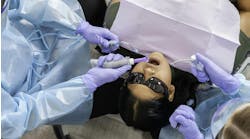Andy Jensen
Not far from downtown Los Angelesis a most interesting geological feature called the La Brea Tar Pits. The tar pits are fed by crude oil that seeps up from the 6th Street Fault. For hundreds of years, local native tribes used the tar to caulk their boats. In more recent times, Spanish settlers used the tar to pitch their roofs and heat their homes. In 1901, geologist W. W. Orcutt first recognized that the bones frequently found in the tar pits were prehistoric fossils. For that "a-ha!" moment, paleontologists named the prehistoric La Brea coyote (Canis orcutti) in Mr. Orcutt's honor.
Major excavations in the early 1900s led to the discovery of fossilized bones of many different prehistoric animals, such as saber-toothed cats and mammoths. The tar pits are a gem for paleontologists because of the sheer number and remarkably preserved condition of fossilized skeletons (the tar protects the bones from bacterial degradation). Excavation continues daily, and according to the museum, something new is discovered every week.
So, how exactly, does a powerful mammoth or sleek saber-toothed cat manage to get stuck in the tar? In the case of the tar pits, the oil reaching the surface turns into asphalt as it biodegrades or evaporates. The asphalt, obscured by water, dirt, and debris, would occasionally become thick enough to trap an animal. Animals walking across the surface, often to prey on other trapped animals, became trapped and died. As a result, the La Brea Tar Pits are a source of continued excitement for every paleontologist.
Perhaps a layer of water, dirt, and dead foliage has covered a few tar pits of dental technology. As a result, it may be difficult for some doctors to recognize the danger beneath. I'm speaking figuratively, of course; to my knowledge, no doctor or team member has become trapped by sludgy dental software. There may be an argument that a practice or two has passed on due to stinky software, but I'll table that topic and discuss at a later date, perhaps.
Unfortunately, the tar pits of dental technology are covered by frequent and loud marketing messages - more specifically, by dealer representatives within the walls of the dental practice. That doesn't make the representatives a bad person; on the contrary, I have known many that have done good things. I'm not assigning blame or pointing fingers, only stating a fact: It's difficult to see or hear anything other than what the large software vendors want you to see and hear.
The difficult thing to see - the peril that lies beneath - is that the software still widely sold to unsuspecting doctors is out of date. Once a doctor is mired in decades-old technology, they're trapped for a long time. Some spend thousands of dollars for fossilized code; others are lured by open-source software that's just as old and just as sticky.
The most current technology platform for software is the cloud. There are only a handful of true cloud-based systems available for the dental practice - Curve Dental being perhaps the leader of the pack. I use the word "true" because most of the larger dental software vendors have slapped "cloud" stickers on their packaging for marketing purposes. (My latest white paper addressing this issue, "How to Recognize True Cloud-based Dental Software," is available from Curve Dental.)
Avoiding these tar pits is a matter of observing how technology is impacting your life outside of the practice. Cloud computing is a daily experience for most of us. It's interwoven into our social life, our entertainment, our finances, and our behavior as a consumer. Whenever we power on a tablet or pop open a laptop, chances are we're using the cloud to accomplish a task with convenience and simplicity. The cloud is not the future; it's the present.
As I see it, there are only two choices: You can stick with the old (which will certainly stick to you), or you can embrace the present and benefit from the convenience and simplicity of the cloud.
Andy Jensen has 20 years of dental software experience. He hopes one day to see pre-cloud, fossilized dental software only in museums. He is currently a member of the Curve Dental team based in Orem, Utah.





